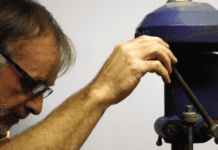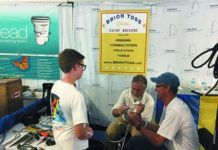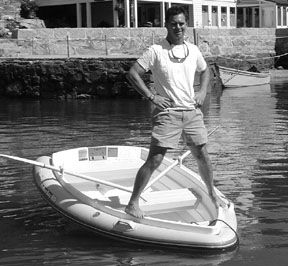
What defines an “all-star” product? By one criterion it should be one that outsells others in its category. By another, it should be one that outperforms its competition. Neither of those criteria work here: We don’t care how much money it makes for its maker, and although our main job in this publication is to assess relative performance merits among similar objects, the general purpose of our Chandlery column is to allow us to mention good products that may be one-offs, or that can’t or needn’t be group-tested in a feature length article. Yet there are some products that we’ve covered in Chandlery that seem to have particular appeal, maybe because we regularly hear good news from readers about them, or we find ourselves using them and relying on them—or maybe just looking forward to the next time we can use them. So we thought we’d mention a bunch of them in one place, and decided to call them “All-Stars” because it’s catchier than “Products That Don’t Fit Our Regular Testing Modes But That Are Extra Good for One Reason or Another.”
Walker Bay Boats
We’ve published extensive reviews of Walker Bay’s offerings—the 8- and 10-footers in the September 2001 issue, and the 9-foot rigid inflatable dinghy (RID) in the November 1, 2003 issue. But we’ve run those reviews in the Chandlery section because, considering the way they’re marketed and sold—positioned almost as impulse buys in the chandleries— they’re as much boat gear as boat. These polypropylene resin products are mass-produced and delivered in stacks; they’re fitted out (and stiffened) with solid, foam-filled thwarts, and all of a sudden they’re boats—not very salty in the classic sense, but light and easily carried, or rolled with their built-in transom wheels. They can take all sorts of abuse without damage, and they’re docile alongside the mother ship.
None of this would count for much, in our book, if they weren’t also capable in their basic functions of rowing, towing, motoring, and even sailing. But they are. The hull forms are fairly fine at the bow, which allows them to row and tow straight, and flat and stable aft. The 9-foot LOA RID is basically the 8-footer, fitted with a removable V-shaped inflatable tube, which adds yet more flotation and fender protection, and the stability that some people may have missed up forward.
If you need an all-inflatable boat, you’re obviously out of luck here. However, solid dinghies have many merits—they tow and row better than inflatables, and, size for size, have more carrying capacity. In Walker Bay boats, good trim is important. Crew and gear weight needs to be centered (tiller extensions are almost a must for single-person outboard operation) if the hulls are to perform up to spec.
There are all sorts of combinations now possible for these boats—sailing rigs, retrofit tube kits, better floors, better oars, and so on. The current price for the basic 8-footer at West Marine is $700.
Contact – Walker Bay Boats, 888/449-2553, www.walkerbay.com.
———-
Anti-Bond 2015
There are some remarkably tenacious and long-lasting goops to hold boats and boat parts together, but when you’ve overdone it with an aggressive adhesive/sealant, or need to un-mount and replace a piece of gear, there’s often a lot of work to be done. Overdaubs of 3M 5200, moving glacially but inexorably when the back is turned, spring to mind. So do narrow crevices that have to be attacked tediously with razor blades or serrated knives.
A product called Anti-Bond 2015 is, in our experience, the best ally in these circumstances. It does not by any means make a difficult job easy—you will still have to attack those crevices. But the Anti-Bond does make the chore far less difficult. It doesn’t dissolve the sealant; instead it loosens the bond between the sealant and whatever surface it’s mated to. You spray it on at the edge of the bond, wait 10-20 minutes, then begin digging, clearing away the loosened material and reapplying Anti-Bond as you go. Sometimes it takes several applications. Again, it’s an ally, not the universal solvent.
Here are test notes from our last report:
“We took a clean, gelcoated fiberglass panel and attached small strips of fiberglass to it, using a variety of urethane adhesives. Since some of these cure slowly, we waited for three months before trying to remove the strips…Anti-Bond works. The strips we tried to remove without it simply refused to come free. When we did pry them off, chunks of gelcoat came with them. The ones on which we used Anti-Bond came off cleanly, though they required some prying and three or four applications of Anti-Bond.”
Anti-Bond is not well documented online by its manufacturer, JWB Environmental, but if you put “Antibond 2015” into Google, you can find it for sale in many places. A four-ounce can sells for roughly $13-$15.
Contact – JWB Environmental, Inc., 407/327-5500.
———-
Silent Running – SR 1000
Silent Running 1000 is a water-based, non-toxic, U.S. Coast Guard-approved coating used for sound and vibration dampening. It can be used on fiberglass, metal, or other surfaces, and dries into a visco-elastic state, working to deaden noise by absorbing sound energy and converting it to small amounts of heat.
Although we only reported on this product for the first time this past summer, there’s been a steady buzz about it since it won the Product Innovation Award at last year’s International Boatbuilders’ Exhibition & Conference (IBEX), and we’ve stayed intrigued since.
The most obvious use for Silent Running is on the inside of engine compartments, particularly in boats where engines are already shoe-horned into tight spaces, or in spots where thick, foil-fronted sound insulation is difficult to apply.
For our original Chandlery report on SR 1000, we did a simple vibration test, comparing the sound of two sheets of metal when hit by a hammer. One sheet was bare, the other had two coats of fully cured SR 1000. The first went “bonnnnggg,” and the second went “thud.” Rigorous test— mission accomplished.
After that report, we bought two gallons of SR 1000 ($120 each) and coated the inside of a big wooden engine box in the cockpit of one of the boats we use to test gear for Practical Sailor. The engine box already had an inch of insulation sandwiched between thin layers of plywood all around, but was still loud, and the clearances weren’t enough to add another insulation layer. We took decibel readings at seven locations around the box at an 800 rpm idle, and got an average of 94 dB. We then applied SR 1000 by brush, gave it a few days to cure fully, and took readings again. The results were good—an average of 89 dB around the box at the same rpm.
SR 1000 is best sprayed on, but can also be applied by brush or roller. While two sprayed coats are recommended, the main idea is to build the thickness to about 40-50 mils (40 mils is about one millimeter). It took four coats by paintbrush on the engine box to get the job done. The results were not smooth, but they were thick enough.
At about $3 per square foot (for two coats), SR 1000 compares favorably with bulkier sound insulation. It’s certainly not an automatic replacement for sheet insulation, which will be faster and easier to apply in many instances, but SR is effective, too, and we can think of other places where it would make a big quality-of-life difference in the boats we run.
Contact – Current, Inc., 877/436-6542, www.silentrunning.us.
———-
Mr. Funnel (Fuel Filter Funnel)
Clean air, clean oil, and clean fuel are the three main support legs of a healthy engine, especially a diesel, and of those three it’s the fuel that will let you down the fastest if it’s contaminated with water, dirt, bacteria, or sludge. It’s important to be scrupulous about putting in clean fuel in the first place, and keeping the tanks topped up to prevent condensation. (It’s water in the tank that breeds the beasties that cause the sludge…)
We have reported many times on that first line of defense—the deck-fill fuel filter—and in recent years we have favored Mr. Funnel, a.k.a. the Fuel Filter Funnel, made by Smart Tech LLC in Alaska and sold under different names by West Marine and other outlets. It’s a plastic funnel with a filter element made of Teflon-coated stainless steel, set in a cylindrical arrangement over a sump. The sump catches any amount of water that might be in the fuel, and the filter catches particulate matter and water droplets that might be held momentarily in suspension (although water settles almost immediately to the bottom of any fuel vessel).
The funnels are sold in several sizes and flow rates range from 2.5 to 15 gallons per minute. (The flow rate should be calibrated to the patience levels of the skipper, the fuel-dock attendant, and the attitudes of the people waiting in line behind you for fuel. The faster the flow, the better, but you’ll pay for it.) The smallest version is about $18 and the largest about $65.
Since we began reporting on Mr. Funnel, several readers have written to ask what’s supposed to be done with the fluid that collects in the filter sump. In a pinch, it can be absorbed with a few paper towels or a piece of fuel-absorber pad like those made by 3M. Those absorbers must be disposed of properly. A better plan is to keep a clean glass jar with a lid on board, and pour the sump fluid into that. It will give you a chance to inspect the fluid for debris.
Contact – Smart Tech LLC, 907/688-1550, www.mrfunnel.com.
———-
Sea Sense Road Warrior
If there’s one piece of boat-related gear that can be counted on to fail with dismal regularity, it’s the trailer light—the incandescent kind whose housing is submerged regularly or even occasionally, and then left to the vagaries of hot and cold weather, and abuse by bouncing, bumping, and being kicked and stood upon. They will last longer if regularly inspected and maintained, but trustworthy they ain’t, especially if they have to be opened up for a bulb replacement.
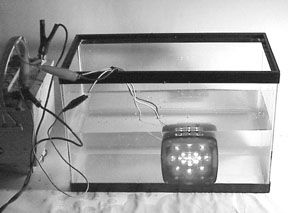
So a trailer light composed of LEDs in a potted housing is a great idea. Back in 2003, we abused a SeaSense Road Warrior submersible trailer light to an almost comic degree. Here’s an excerpt from the report: “We hooked one up to a 12-volt battery and submerged it in eight feet of Long Island Sound water. It worked fine. We left it submerged and running for a week. Still worked fine. Then we left it submerged and turned the light on and off at 30-minute intervals to see if changing internal temperatures would affect it. Still worked fine. We took it out of the water and placed it on a vibrating table for four hours to see if road shock would damage it. When we tried it again, it showed no ill effects. We finally got mad, tied it to a car’s bumper, and dragged it around the block a couple of times. The plastic housing was scratched badly, but the lighting was unaffected. Last…we drilled a couple of holes in the lens and allowed the housing to fill up with water. When we submerged it again, it still worked…The Road Warrior is as close to indestructible as any light we’ve encountered.”
You can find a Road Warrior kit, with left and right lights, license platebracket, 25′ wire harness, 4′ trunk connector, and mounting hardware for $50 at www.overtons.com. There’s a 10-year warranty on the LED parts.
Contact – SeaSense Marine Accessories, 800/282-8725, www.seasense.com.
———-
Speedseal
Last covered in the July 15 issue this year, the Speedseal has appeared in our pages several times. It’s a British-made replacement cover plate for an inboard engine’s raw-water pump. Made out of 1/4″ naval brass, it carries a nitrile O-ring to complete the seal against the pump housing, eliminating the need for paper gaskets. It uses knurled screws that can be set by hand, and the plate has two edge slots that slide behind two of the screws, thus making it easier to set the plate in difficult conditions (roughness, darkness) with one hand. With the slots, alignment of the other two screws with their holes is automatic.
As we said in our latest article, “Lest you think such a piece of gear is unnecessary or unimportant or uninteresting, consider the following scenario: You’re cruising along under power, your raw water intake manages to suck a plastic bag up against itself, and within a few seconds your engine is no longer being cooled. If you were to look over the stern, you’d see no water coming out the exhaust. But you don’t notice until the temperature gauge pegs to the right. Even if you shut down and figure out the cause of the problem before your engine suffers damage, there’s a fair chance that your impeller, having been spinning dry inside the pump bore, is shot, and needs to be replaced with the spare you prudently stowed on board… somewhere…a couple of years ago. Add to this scenario choppy conditions, a lee shore, a crew wailing and gnashing their teeth, and you realize that the ability to change an impeller quickly is a good thing.”
The Speedseal can be ordered from England by phone or on the web. The cost is $59 plus $9 shipping.
Contact – Speedseal, 800/675-1105, www.speedseal.com.
———-
LINK Tools
In a salty environment, we tend to consider our on-board tools either as essentially disposable, and content ourselves with mediocre, rust-prone implements that usually get the job done, given a squirt of WD-40 and a prayer, or think of them as trusted shipmates that should work reliably with minimal maintenance. In the first case, if you drop one over the rail, you don’t choke up; in the second case, you do. LINK tools, reviewed in the July 15, 2002 issue, are of the latter variety. They are superbly made, devilishly clever and convenient, and cost quite a bit of money.
The two hallmarks of the LINK tools are their main construction material—heat-treated chrome vanadium steel (first plated with nickel, then with chrome), and their proprietary locking mechanisms. The locks use steel pins, not spring-loaded balls, to secure sockets and extensions. When two pieces are locked together, they stay together, period, until you release them by pulling up on the locking collar. This can be done with one hand, which is nice if your other hand is busy, or you’re working in tight quarters. With most socket wrench sets, if you add extensions and joints, you quickly induce play in the system, and you’re likely to have a hard time keeping things in line. How many times have you added an extension and socket to a ratchet and had either the socket or the extension and the socket come loose and drop into the bilge? With a LINK set-up, this won’t happen.
The 41-piece, 3/8″ set we tried included a UniDriver (nut driver), a ratchet handle, 2″ and 6″ extensions, a locking U-joint, 9 SAE sockets, 11 metric sockets, spark plug sockets in two sizes, and a variety of socket-mounted bits in Allen, Torx, Philips, and slotted configurations.
The kit is available now at West Marine for $200. For some, such a tool kit will be considered an indulgence, but the more you tinker with your boat, the more LINK tools make sense.
Contact – LINK Tools, 888/433-4234, www.link-tools.com.
———-
Swobbit Perfect Pole
Deck brushes, mops, squeegees, and boathooks, in their profusion, can be difficult to stow, and most are cheesy. Mop and brush handles break after a few sessions of mild elbow-grease, and telescoping poles elongate or collapse at all the wrong moments. So it’s nice to have one pole, telescoping or fixed, that can act as a host for different attachments.
Back in August of 2002, we reviewed a bunch of multi-purpose boat poles, and came away with a clear winner—the Perfect Pole, which exists at the heart of a marketing maelstrom called the Swobbit System, designed to claim supremacy among the cleaning products in the marine, aviation, RV, and automotive worlds. Marketing aside, the Perfect Pole is no bull. It’s a pin-locking type (as opposed to the less reliable twist-lock) made of two tubes of polished anodized aluminum. It’s heftier and stronger than other aluminum poles, partly because of the longitudinal stiffness of the teardrop-shaped outer tube, which houses a channel for the inner tube’s locking button mechanism. The channel keeps the button aligned fore and aft with the adjustment holes; there’s no twisting movement, which means the pole can be operated by feel alone.
There are lots of snap-in attachments for the Perfect Pole, including a tip with a standard threaded end, so that you can add your own favorite bush or mop head if Swobbit’s products don’t do the trick for you. We’ve mostly used a boathook tip in ours, with good results.
A 3′ to 6′ telescoping Perfect Pole is $29.95. The 5′ to 9′ is $39.95. Attachment costs vary. The boathook tip is $12.95, as is the snap-in threaded adapter.
Contact – Swobbit Products, 800/252-1986, www.swobbit.com.
———-
Ventair
Problems of wetness, mold, mildew, and general funkiness are all too common on boats in hot and muggy climates, especially in bedding areas, yet many of us just seem to accept these conditions. We know that simple air circulation can make all the difference, but often imagine solutions that demand electricity, conduits, and more hassles than we can muster the energy to deal with.
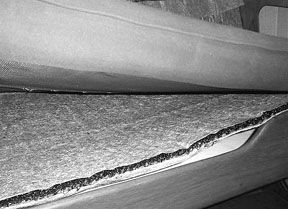
It doesn’t have to be that way. One of the simplest, easiest-to-install circulation achievers we’ve run across is the Ventair pad, which we described in the March 2004 issue as a “semi-dense mat of fine plastic wire, sandwiched between polyester tissue fabric that allows airflow.”
The 15 mm. bunk pads (5/8″ x 39″ x 78″) cost $55, plus shipping of $8.50 per carton. A thinner, 10-mm. pad for use behind seat cushions is also available by special order. The pads are easily cut to fit with scissors. They’re impervious to moisture, and crush-proof, springing back to form immediately. They have continued to work well in the challenging conditions of a converted wooden Chesapeake Bay boat (built in 1925), the liveaboard test boat on which we placed the cushions over two years ago. This is a simple, inexpensive, and effective solution to a big problem.
Contact – Ventair USA, 954/926-2838, www.ventairusa.com.
———-
Tommy Tape
Self-bonding (or “self-amalgamating”) tape is made of silicone with a plasticizer that enables the tape, when stretched waaaaaaayyy out, to adhere and bond to its previous wraps, forming what is essentially a unified mass of rubber.
We tested seven such tapes in 2001, and a product called Tommy Tape emerged as the Best Buy, having equaled West Marine Rigging Tape in longevity outside in the sun (one full year) while costing substantially less. In June ’04, we reported the results of a head-to-head test between Tommy Tape and a new and worthy challenger, X-treme tape, which was priced almost identically. Tommy Tape prevailed by a nose in the wild.
As we said in our 2004 article, “With this watertight silicone tape, you can seal electrical connections, do emergency fuel or water hose repairs, insulate, make pressure bandages (even splints), whip rope ends, stop leaks, reduce vibration, pad wear points, wrap tool grips—anything on which you can get a couple of wraps.”
Contact – Tommy Tape, 860/378-0111, www.tommytape.com.






























